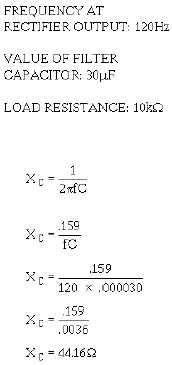4-22
As you can see from the calculations, by doubling the frequency of the rectifier, you reduce the
impedance of the capacitor by one-half. This allows the ac component to pass through the capacitor more
easily. As a result, a full-wave rectifier output is much easier to filter than that of a half-wave rectifier.
Remember, the smaller the XC of the filter capacitor with respect to the load resistance, the better the
filtering action. Since
the largest possible capacitor will provide the best filtering. Remember, also, that the load resistance is an
important consideration. If load resistance is made small, the load current increases, and the average value
of output voltage (Eavg) decreases. The RC discharge time constant is a direct function of the value of the
load resistance; therefore, the rate of capacitor voltage discharge is a direct function of the current through
the load. The greater the load current, the more rapid the discharge of the capacitor, and the lower the
average value of output voltage. For this reason, the simple capacitive filter is seldom used with rectifier
circuits that must supply a relatively large load current. Using the simple capacitive filter in conjunction
with a full-wave or bridge rectifier provides improved filtering because the increased ripple frequency
decreases the capacitive reactance of the filter capacitor.
Q14. What is the most basic type of filter?
Q15. In a capacitor filter, is the capacitor in series or in parallel with the load?
Q16. Is filtering better at a high frequency or at a low frequency?
Q17. Does a filter circuit increase or decrease the average output voltage?
Q18. What determines the rate of discharge of the capacitor in a filter circuit?



